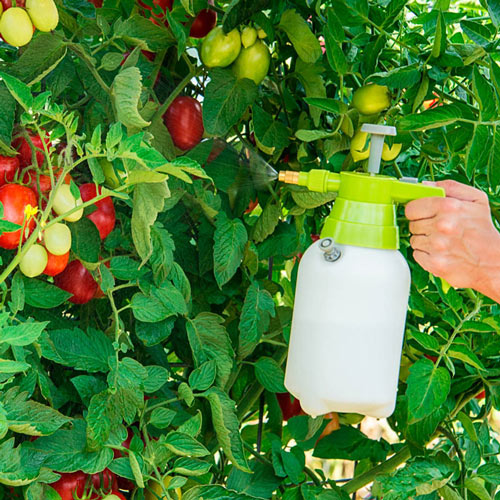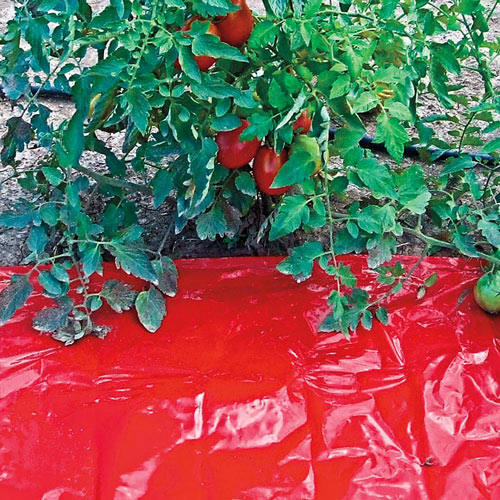Blight vs Wilt; a Treatise on Tomato Troubles
-
Helpful Products from Gardens Alive!
-
 Handy Pressurized Sprayer
Handy Pressurized Sprayer -
 Turbo-Tomato!™ Mulch Sheet
Turbo-Tomato!™ Mulch Sheet
Q. Melissa in Lawrenceville New Jersey writes: "I have a question about the soil in my raised beds. For the last couple of years my tomato plants have had what I think is blight. (I did not have that verified.) The plants start off great, then mid-season through harvest time the bottom leaves turn yellow, then brown and then fall off. What's interesting is that I get a good crop anyway, but I want to grow healthy plants. This Spring I am redoing the beds, which means adding about a foot of soil on top of what is already there. If the existing soil is problematic, how do I add the new soil so as to not contaminate it?"
A. First, I want to make an impassioned plea not to use the word 'blight' lightly. Tomatoes and other plants are prone to many disease problems, but "blight" is Biblical. You don't just get a couple of discolored leaves if Late Blight strikes your garden; you get dark brown lesions on the leaves and fruits, and within a week the entire plant will be, as the Coroner of Oz once remarked "not only merely dead, but really most sincerely dead". (Parts of this pathogen's Latin (actually Greek) name mean 'decay, ruin and perish'.)
Although this is the same pathogen that caused the great famine in Ireland in the 1840 and 50s, it's originally from Mexico--and to quote the fine folks at the Cornell plant pathology lab, "during the early 1990s, several exotic strains of late blight were introduced that are more aggressive than the earlier ones." Great.
There was a major outbreak of Late Blight in the United States in 2009. It started with cheap, big-box store-bought plants but spread rapidly to other gardens. Even my tomato plants got hit--rapidly withering and turning black. Luckily, I was already in touch with Cornell and knew to quickly destroy the plants; because this is a Typhoid Mary disease, sending the spores of the deadly pathogen into the air to kill tomato (and potato) plants in surrounding gardens. Every affected plant can produce one hundred to three hundred thousand new spores a day.
Extension Bulletins will often suggest options for fighting the pathogen, but in truth there is no cure for blight--once you see the first symptoms the plants are goners. The only thing you can do is protect the plants of nearby gardeners by quickly bagging your affected plants, letting the bags roast in the sun for a week and then putting them out in the trash. Luckily, the spores do not survive winter aboveground, so you'll start the next season with a clean slate.
Enough with blight. What Melissa is describing sounds exactly like Verticillium wilt, a pesky but easily manageable condition that occurs when tomatoes are grown in the same spot year after year. (Which makes it the PERFECT topic for this time of year, just before tomato plants are positioned for the season!) The wilt organism is ubiquitous is regions with cold winters; in warmer climes, its nasty cousin Fusarium is generally to blame. Technically, the wilts affect a large number of plants, but to tomatoes they are Kryptonite.
The first year a tomato plant occupies a certain spot, the wilt essentially breeds on the roots--but nothing bad happens. The second year in the same spot the wilt breeds more aggressively and you may see some yellowing of leaves at the bottom of the plant, but nothing major. By year three, the yellowing starts sooner and progresses faster. If you plant there again in Year Four, your plants will typically succumb by late July.
The easiest answer is to use dated, sturdy metal plant tags to indicate where your tomatoes grow each season. Use that spot for two years running and then rotate the plants to another spot. Without tomato roots to breed on, the wilt will slowly die back in the newly unplanted areas. If you're a gambler, you can try replanting tomatoes there after a two-year break. If you're a conservative investor, wait for the third year. In the meantime, you can--and should--plant other crops in those spots, although not potatoes or eggplant.
Yes, many of us have trouble following this routine because we have small gardens or--in my case--grow way too many tomatoes. If this sounds like you, consider planting at least some tomatoes that have the letters V and F listed after their variety names; they've been found to have some resistance to the wilts. Grafted tomatoes--the variety of fruit you desire grafted onto a rootstock that is VERY resistant--are a great option; just remember to keep the graft above the soil line or you'll grow the fruits that the rootstock would produce, which are not good tomatoes.
If the wilt strikes your plants this year, don't panic; just remove the affected leaves right away. This will not slow the spread of the disease one bit, but it will make you look like a better gardener to your neighbors. It will also open up the bottom of the plant to better airflow, which can help prevent lots of other tomato troubles. And if the tomato variety in question is a rampant indeterminate variety, it should 'outgrow' the disease and produce a good number of fruits that season anyway. But be sure to mark that area for the following year and provide at least a two-or-three-square foot tomato-free space whereever the wilts came
A. First, I want to make an impassioned plea not to use the word 'blight' lightly. Tomatoes and other plants are prone to many disease problems, but "blight" is Biblical. You don't just get a couple of discolored leaves if Late Blight strikes your garden; you get dark brown lesions on the leaves and fruits, and within a week the entire plant will be, as the Coroner of Oz once remarked "not only merely dead, but really most sincerely dead". (Parts of this pathogen's Latin (actually Greek) name mean 'decay, ruin and perish'.)
Although this is the same pathogen that caused the great famine in Ireland in the 1840 and 50s, it's originally from Mexico--and to quote the fine folks at the Cornell plant pathology lab, "during the early 1990s, several exotic strains of late blight were introduced that are more aggressive than the earlier ones." Great.
There was a major outbreak of Late Blight in the United States in 2009. It started with cheap, big-box store-bought plants but spread rapidly to other gardens. Even my tomato plants got hit--rapidly withering and turning black. Luckily, I was already in touch with Cornell and knew to quickly destroy the plants; because this is a Typhoid Mary disease, sending the spores of the deadly pathogen into the air to kill tomato (and potato) plants in surrounding gardens. Every affected plant can produce one hundred to three hundred thousand new spores a day.
Extension Bulletins will often suggest options for fighting the pathogen, but in truth there is no cure for blight--once you see the first symptoms the plants are goners. The only thing you can do is protect the plants of nearby gardeners by quickly bagging your affected plants, letting the bags roast in the sun for a week and then putting them out in the trash. Luckily, the spores do not survive winter aboveground, so you'll start the next season with a clean slate.
Enough with blight. What Melissa is describing sounds exactly like Verticillium wilt, a pesky but easily manageable condition that occurs when tomatoes are grown in the same spot year after year. (Which makes it the PERFECT topic for this time of year, just before tomato plants are positioned for the season!) The wilt organism is ubiquitous is regions with cold winters; in warmer climes, its nasty cousin Fusarium is generally to blame. Technically, the wilts affect a large number of plants, but to tomatoes they are Kryptonite.
The first year a tomato plant occupies a certain spot, the wilt essentially breeds on the roots--but nothing bad happens. The second year in the same spot the wilt breeds more aggressively and you may see some yellowing of leaves at the bottom of the plant, but nothing major. By year three, the yellowing starts sooner and progresses faster. If you plant there again in Year Four, your plants will typically succumb by late July.
The easiest answer is to use dated, sturdy metal plant tags to indicate where your tomatoes grow each season. Use that spot for two years running and then rotate the plants to another spot. Without tomato roots to breed on, the wilt will slowly die back in the newly unplanted areas. If you're a gambler, you can try replanting tomatoes there after a two-year break. If you're a conservative investor, wait for the third year. In the meantime, you can--and should--plant other crops in those spots, although not potatoes or eggplant.
Yes, many of us have trouble following this routine because we have small gardens or--in my case--grow way too many tomatoes. If this sounds like you, consider planting at least some tomatoes that have the letters V and F listed after their variety names; they've been found to have some resistance to the wilts. Grafted tomatoes--the variety of fruit you desire grafted onto a rootstock that is VERY resistant--are a great option; just remember to keep the graft above the soil line or you'll grow the fruits that the rootstock would produce, which are not good tomatoes.
If the wilt strikes your plants this year, don't panic; just remove the affected leaves right away. This will not slow the spread of the disease one bit, but it will make you look like a better gardener to your neighbors. It will also open up the bottom of the plant to better airflow, which can help prevent lots of other tomato troubles. And if the tomato variety in question is a rampant indeterminate variety, it should 'outgrow' the disease and produce a good number of fruits that season anyway. But be sure to mark that area for the following year and provide at least a two-or-three-square foot tomato-free space whereever the wilts came
-
Helpful Products from Gardens Alive!
-
 Handy Pressurized Sprayer
Handy Pressurized Sprayer -
 Turbo-Tomato!™ Mulch Sheet
Turbo-Tomato!™ Mulch Sheet







 Gardens Alive! & Supplies
Gardens Alive! & Supplies




